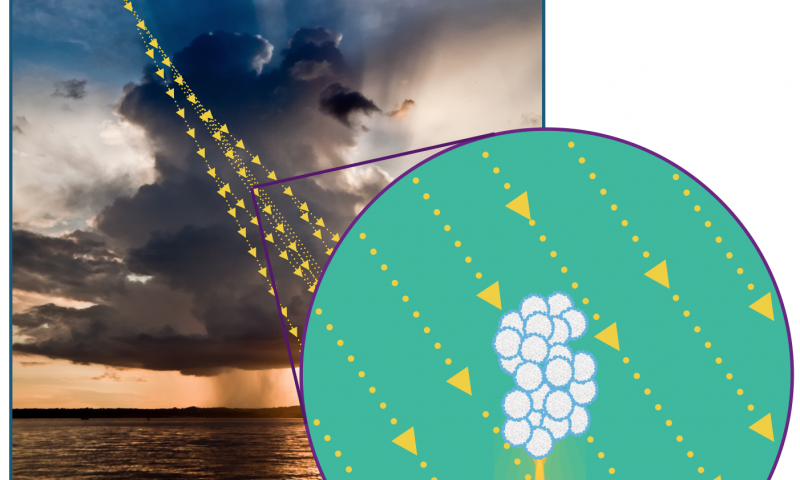I'm not referring to space lightning – or electrical phenomena in far away galaxies, but the normal earth system kind of lightning, of the everyday everywhere thunderstorm. According to a new model of its behaviour lightning has a cosmic trigger – go to http://phys.org/print354951242.html …
 electrons with an origin in the solar wind, and perhaps cosmic rays from further afield, are involved in the process of creating lightning, and scientists at the University of Groningen in the Netherlands think they know how it happens – by modelling a few of the ingredients. Charge separation occurs inside thunder clouds and in turn are short circuited by a conductive tube of ionised air. However, it seems the field inside the clouds are too weak for this to happen – so they have looked around for a boost. The model of how lightning might form begins on the mainstream idea it involves ice particles. These are now said to grow into large globular ice particles with a tear drop feature – out of hailstones within the thunder cloud. They become elongated and this shape appears to focus the electric field, gathering at the tips of the elongated ice particles, a necessity to create a conductive tube.
electrons with an origin in the solar wind, and perhaps cosmic rays from further afield, are involved in the process of creating lightning, and scientists at the University of Groningen in the Netherlands think they know how it happens – by modelling a few of the ingredients. Charge separation occurs inside thunder clouds and in turn are short circuited by a conductive tube of ionised air. However, it seems the field inside the clouds are too weak for this to happen – so they have looked around for a boost. The model of how lightning might form begins on the mainstream idea it involves ice particles. These are now said to grow into large globular ice particles with a tear drop feature – out of hailstones within the thunder cloud. They become elongated and this shape appears to focus the electric field, gathering at the tips of the elongated ice particles, a necessity to create a conductive tube.
Normally there are too few free electrons in the air to cause a discharge and this is where cosmic rays come in as they are able to generate large showers of free electrons. The research has used computer simulation – which relies on the veracity of the input. What does the Electric Universe people say about this? Wal Thornhill, page 46-51 of The Electric Universe (2007), perceived the Earth as a charged body connected to the Sun's electric field, and storms, lightning and sprites are manifestations of a single phenomenon. Lightning is the spark at a celestial current as it connects to the Earth. The structure does not require charge separation (as described above) only a mechanism for charge recomibination (electrical discharging). This is achieved by the electrically driven rapid vertical movement of air in a storm that typically precedes a lightning strike.
The difference between lightning below and above the clouds is a matter of atmospheric density. Very low air pressure at great heights affects the size and colour of sprites (a recent one reported here last week was bright red). The actuality of sprites is enough to show the electric current stretches high above the clouds towards space. Thunderstorms are not electrical generators, he says, they dissipate energy on an interplanetary circuit like a self repairing leaking capacitor. The charge across the cloud 'capacitor' gives rise to ionisation and violent veritcal electrical winds within the cloud. The positive cloud-to-ground from a cloud top simply creates a short circuit to high altitudes in the storm where the glowing form of the discharge, the sprite, flashes in the upper atmosphere. He then goes on to describe some findings from Stanford University in 1998 – where charges were found to occur above the sprites (in the plasma regions of the ionosphere), distruabances that revealed currents flowing from the even higher Van Allen belts. He continues, it can no longer be doubted that the electrical events we see in thunderstorms are inseparable from electrical events above the clouds. In fact, whenever scientists have looked higher up in the sky they have discovered more electrical activity. By attempting to explain lightning through the behaviour of water droplets (or elongated hail stones) in turbulent thunderclouds, atmospheric physicists limit themselves to the water in those clouds. Lightning has been seen on Venus (lots of it) – which has no water but is said to have an atmosphere that is something like a hot smog (a very hot pea soup concoction). Lightning has been seen on Jupiter – and its moons (even those without an atmosphere), which suggests there is something wrong with the settled science of thunder and lightning.
Going back to the PhysOrg posting – scientists are still seeking to explain lightning by water (ice particles) and they have modelled only those features of storms they find relevant (at the momnet). What is different is that they have seen that cosmic rays play a role – by injecting them into their model. What would have emerged if they had first digested what Wal Thornhill had to say and included this as a component of their models?
